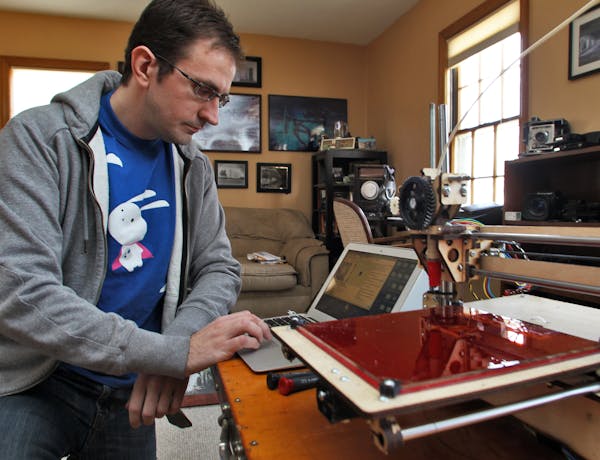The machine, no larger than a coffee maker and encased in black like Darth Vader's helmet, hums at a whisper.
Swinging open the shell's door reveals a slim metal nozzle moving smoothly over a platform, putting down melted black filament in thin layers that form a set of simple chess pieces.
The plastic figures might not look like much, but to Zach Kaplan, the 3-D printing technology creating them represents the early promise of digital manufacturing, powered by desktop machines, user-friendly design software and creative people tinkering away in basements and garages.
As CEO of Chicago-based Inventables, an online retailer of materials for product designers and artists, Kaplan is finding new customers among small businesses and budget-strapped hardware start-ups.
He and other proponents of digital fabrication say the technology's increasing accessibility is emboldening a new generation of participants in the manufacturing sector, reinvigorating the industry as the creation of a single item or a small batch of products becomes as affordable as mass production.
The 3-D printer making the chess set at Inventables costs $899 on the company's website, while one spool of filament, enough to make 360 pieces, is $39. The accompanying design software can be run on a basic computer.
"Inventables used to only be able to service the most well-funded R&D groups," said Kaplan, who launched his business in 2002 to cater to big corporations. "Now we're servicing R&D labs in garages all over the world."
Unlike previous generations of 3-D printers, milling machines and laser cutters, many of today's models fit on a desktop and are designed for micromanufacturing. That means a custom job or small run, from one to 1,000 units, can be as inexpensive as outsourcing production but without the fear of giving up quality control to an overseas manufacturer.
The technology's flexibility and forgiving economics are particularly attractive to hardware start-ups that are using digital manufacturing for rapid prototyping and small-scale production. They say making a prototype with a 3-D printer can save thousands of dollars over handing off the work to a design company.
"It's awesome," said Alan Hurt, founder of Light Up Africa, a start-up whose device attaches to a moving object, such as a bicycle, and captures enough energy to charge a cellphone. "I never knew it was possible to make products at little or no cost."
The ability to quickly and inexpensively make quality prototypes also allows start-ups to experiment without running up a huge bill.
That was a big plus for Oso Technologies, a company started by engineering graduate students at the University of Illinois that makes sensors that measure soil moisture content and send alerts to a computer or mobile phone when plants need to be watered.
"There's something about being able to hold and physically interact with a design that feels more real and allows you to get feedback more directly than looking at a 3-D image on a screen," said Eduardo Torrealba, the company's co-founder and CEO.
Electric cars and digital connectivity dominate at Beijing auto show
More than just a bowl of noodles, ramen in Japan is an experience and a tourist attraction
Stock market today: Asian benchmarks mostly slide as investors focus on earnings

